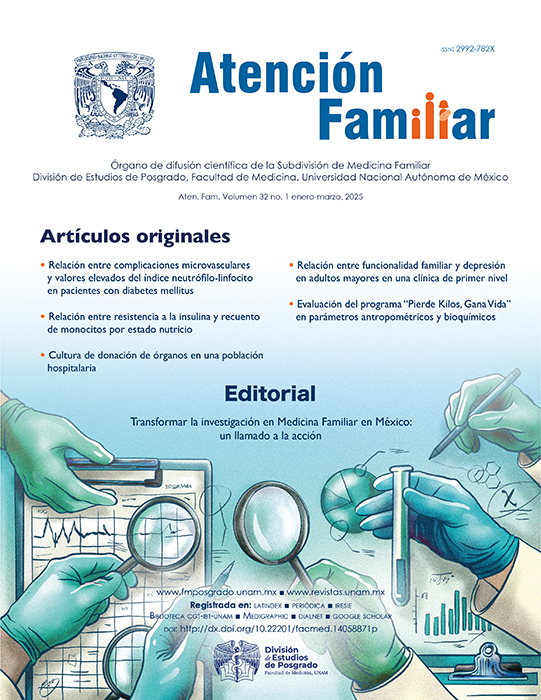Relación entre resistencia a la insulina y recuento de monocitos por estado nutricio
Main Article Content
Abstract
Objective: to analyze the relationship between insulin resistance and monocyte count by nutritional status. Methods: analytical cross-sectional study, carried out at the Family Medicine Unit No. 80 in Morelia, Michoacán. Forty-five adults of both genders aged 18-55 years were selected by non-probabilistic sampling. Anthropometry, blood collection for blood biometry, blood chemistry, and insulin receptor expression in monocytes were performed. Patients with chronic diseases and altered immunocompromised states were excluded. Six groups were studied according to body mass index category, and with/without insulin resistance (IR). Median, minimum-maximum value was used. For comparisons between groups, the Kruskal-Wallis test, and Dunn’s multiple comparison test were used as post-hoc. Statistical significance was considered with p<0.05. Results: in adults with normal weight (n= 19), 63% presented IR. There was no difference in the number of classical, intermediate, and non-classical monocytes in patients with insulin resistance (p>0.05). No differences were identified in the expression of the insulin receptor in monocyte populations (p>0.05). Conclusion: a high proportion of insulin resistance was found in individuals with normal weight. Future studies are proposed on the influence of insulin resistance on intracellular signaling and secretion of proinflammatory cytokines derived from different monocyte subtypes in individuals with and without IR.
Downloads
Article Details
Citas en Dimensions Service
References
WHO Consultation on Obesity [Internet]. [Citado 2024 Sep 26]. Disponible en: https://iris.who.int/handle/10665/42330
Suárez-Carmona W, Sánchez-Oliver JA, González-Jurado JA. Fisiopatología de la obesidad: Perspectiva actual. Rev Chil Nutr 2017;44(3):226-233.
Blüher M. Obesity: global epidemiology and pathogenesis. Nat Rev Endocrinol. 2019;15(5):288-298.
Campos-Nonato I, Galván-Valencia O, Hernández-Barrera L, Oviedo-Solís C, Barquera S. Prevalencia de obesidad y factores de riesgo asociados en adultos mexicanos: resultados de la Ensanut 2022. Salud Publica Mex. 2023;65(supl_1):S238-S247.
Rodrigo-Cano S, Soriano del Castillo JM, Merino-Torres JF. Causas y tratamiento de la obesidad. Nutr clin die hosp 2017. 2017;37(4):87-92.
Choe SS, Huh JY, Hwang IJ, Kim JI, Kim JB. Adipose Tissue Remodeling: Its Role in Energy Metabolism and Metabolic Disorders. Front Endocrinol (Lausanne). 2016;7:30.
Ota T. Chemokine systems link obesity to insulin resistance. Diabetes Metab J. 2013;37(3):165-172.
Kojta I, Chacinska M, Blachnio-Zabielska A. Obesity, Bioactive Lipids, and Adipose Tissue Inflammation in Insulin Resistance. Nutrients. 2020;12(5):1305.
Yaribeygi H, Farrokhi FR, Butler AE, Sahebkar A. Insulin resistance: Review of the underlying molecular mechanisms. J Cell Physiol. 2019;234(6):8152-8161.
Yazıcı D, Sezer H. Insulin Resistance, Obesity and Lipotoxicity. Adv Exp Med Biol. 2017;960:277-304.
Almeda-Valdés P, Bello-Chavolla OY, Caballeros-Barragán CR, Gómez-Velazco DV, Viveros-Ruiz T, Vargas-Vázquez, A, et al. Índices para la evaluación de la resistencia a la insulina en individuos mexicanos sin diabetes. Gac Med Mex. 2018;154(Supp 2):S50-S55.
Ouchi N, Parker JL, Lugus JJ, Walsh K. Adipokines in inflammation and metabolic disease. Nat Rev Immunol. 2011;11(2):85-97.
Kapellos TS, Bonaguro L, Gemund I, Reusch N, Saglam A, Hinkley ER, et al. Human Monocyte Subsets and Phenotypes in Major Chronic Inflammatory Diseases. Front Immunol. 2019;10:2035.
Friedrich K, Sommer M, Strobel S, Thrum S, Blüher M, Wagner U, et al. Perturbation of the Monocyte Compartment in Human Obesity. Front Immunol. 2019;10:1874.
Human Protein Atlas 2022 [Internet]. [Citado 2024 sep 26]. Disponible en: https://www.proteinatlas.org/ENSG00000171105-INSR/immune+cell.
Ieronymaki E, Theodorakis EM, Lyroni K, Vergadi E, Lagoudaki E, Al-Qahtani A, et al. Insulin Resistance in Macrophages Alters Their Metabolism and Promotes an M2-Like Phenotype. J Immunol. 2019;202(6):1786-1797.
Aguilar-Salinas CA, Olaiz G, Valles V, Torres JM, Gómez-Pérez FJ, Rull JA, et al. High prevalence of low HDL cholesterol concentrations and mixed hyperlipidemia in a Mexican nation-wide survey. J Lipid Res. 2001;42(8):1298-1307.
Barquera S, Rivera JA. Obesity in Mexico: rapid epidemiological transition and food industry interference in health policies. Lancet Diabetes Endocrinol. 2020;8(9):746-747.
Kawai T, Autieri MV, Scalia R. Adipose tissue inflammation and metabolic dysfunction in obesity. Am J Physiol Cell Physiol. 2021;320(3):C375–91.
Encuesta Nacional de Salud y Nutrición 2021 sobre COVID-19. [Internet]. [Citado 2024 Oct 01]. Disponible en: https://ensanut.insp.mx/encuestas/ensanutcontinua2021/doctos/informes/220804_Ensa21_digital_4ago.pdf
Mittal B. Subcutaneous adipose tissue & visceral adipose tissue. Indian J Med Res. 2019;149(5):571-573.
Zatterale F, Longo M, Naderi J, Raciti GA, Desiderio A, Miele C, et al. Chronic Adipose Tissue Inflammation Linking Obesity to Insulin Resistance and Type 2 Diabetes. Front Physiol. 2020;10:1607.
Sidorkiewicz I, Jóźwik M, Niemira M, Krętowski A. Insulin resistance and endometrial cancer: Emerging role for microRNA. Cancers (Basel). 2020;12(9):2559.
Le TKC, Dao XD, Nguyen DV, Luu DH, Bui TMH, Le TH, et al. Insulin signaling and its application. Front Endocrinol (Lausanne). 2023;14:1226655.
Sejooti SS, Naher S, Hoque MM, Zaman MS, Aminur Rashid HM. Frequency of insulin resistance in nondiabetic adult Bangladeshi individuals of different obesity phenotypes. Diabetes Metab Syndr. 2019;13(1):62–67.
Ożańska A, Szymczak D, Rybka J. Pattern of human monocyte subpopulations in health and disease. Scand J Immunol. 2020;92(1):e12883.
Drakopoulou M, Tousoulis D, Toutouzas K. Subsets of monocytes: A driving force of coronary plaque instability?. Hellenic J Cardiol. 2021;62(2):182-183.
Van der Valk ES, Mulder DS, Kouwenhoven T, Nagtzaam NMA, Van Rossum EFC, Dik WA, et al. Monocyte adaptations in patients with obesity during a 1.5 year lifestyle intervention. Front Immunol. 2022;13:1022361.
Cruz-Pineda WD, Parra-Rojas I, Rodríguez-Ruíz HA, Illades-Aguiar B, Matia-García I, Garibay-Cerdenares OL. The regulatory role of insulin in energy metabolism and leukocyte functions. J Leukoc Biol. 2022;111(1):197–208.

This work is licensed under a Creative Commons Attribution-NonCommercial-NoDerivatives 4.0 International License.
